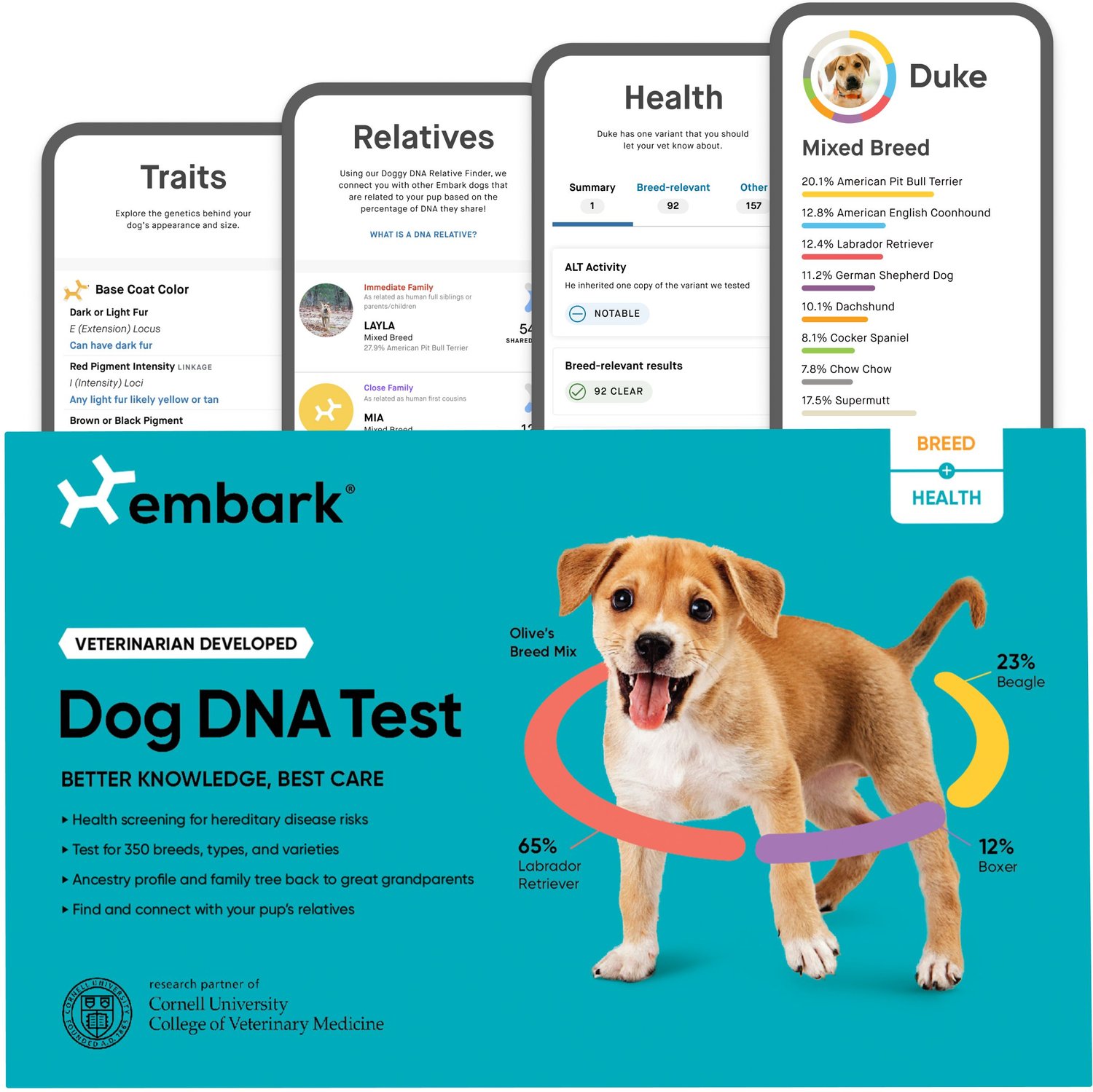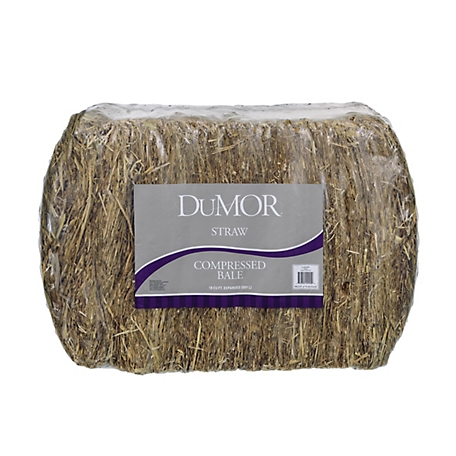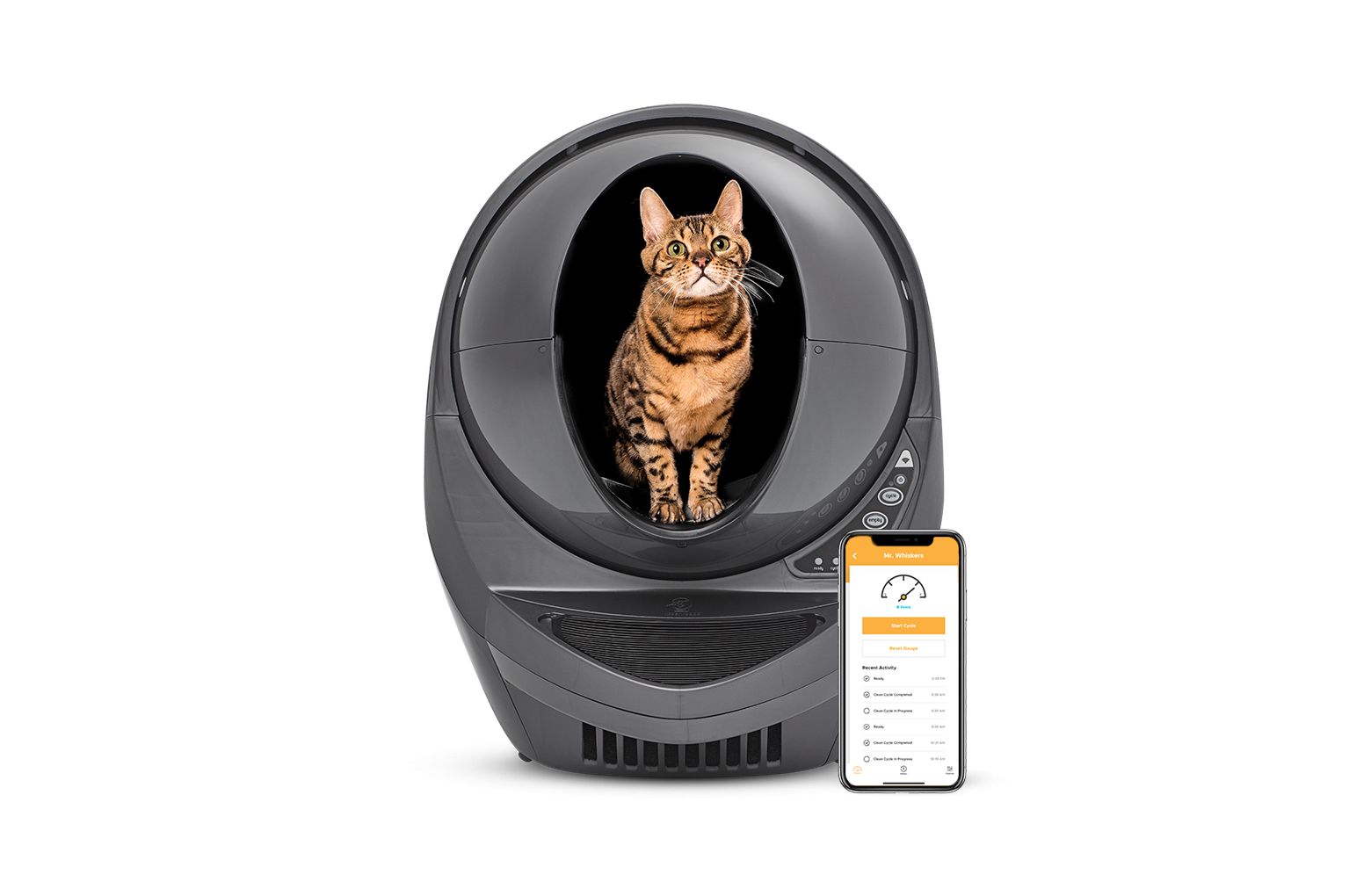- Activate: Visit Embarkvet.com/activate. Updates will be sent to your email address.
- Swab: No eating for 30 minutes before sample collection. Swab the lower cheek pouches to fully soak the sponge.
- Bag: Drop your sample back into the bio-bag. Pull yellow strip and stick to sealing zone.
- Seal: With swab inside, use sticker strip at top of box to seal tightly.
- Mail your kit. The box is also your return mailer, with pre-paid postage on the back. Leave in any mailbox.
Embark Breed Identification & Health Condition Identification DNA Test for Dogs By Embark
-
( 9 Reviews )Rated 5.00 out of 5 based on 9 customer ratings09
Take a deep dive into your dog’s genetics with Embark Breed & Ancestry Identification, Trait & Health Detection Dog DNA Test Kit! With a simple and painless cheek swab, this DNA test can analyze over 200,000 genetic markers, providing you with detailed information about your dog.
-
DuMOR 2-String Wheat Straw Compressed Bale Pet Bedding, 18 cu. ft.
Rated 4.75 out of 504DuMOR 2-String Wheat Straw Compressed Bale Pet Bedding, 18 cu. ft.
Rated 4.75 out of 504 -
Litter-Robot 3 Connect | Self-Cleaning, WiFi-Enabled Litter Box
Rated 5.00 out of 506Litter-Robot 3 Connect | Self-Cleaning, WiFi-Enabled Litter Box
Rated 5.00 out of 506
Take a deep dive into your dog’s genetics with Embark Breed & Ancestry Identification, Trait & Health Detection Dog DNA Test Kit! With a simple and painless cheek swab, this DNA test can analyze over 200,000 genetic markers, providing you with detailed information about your dog, including breed type and family trees going back to great grandparents. This DNA test kit can even help you find his relatives! Embark is suitable for over 350 breeds and also offers important information about your furry friend’s health as it screens for over 200 genetic health conditions, allowing you to prepare and give him the paw-sonalized care he needs. After you send the sample in, you will receive the results through a personalized dashboard in just 2-4 weeks and you can share them with friends and family or print them for your next vet visit. Embark on a journey that can help you learn more about your pet’s genetics and overall health, so you can make the best choices for him and his future!
Key Benefits
- This test uses a research-grade genotyping platform that was created with Cornell University College of Veterinary Medicine. It screens more than 350 dog breeds, helping you find your pup’s genetic makeup.
- Tests for over 200 genetic diseases like glaucoma, MDR1 drug sensitivity, degenerative myelopathy, and common adult-onset diseases.
- Maps your pup’s family tree back to great grandparents and pairs your dog with similar breed mixes. Check out the profiles and photos of closely related breeds on the dashboard to see the resemblance between them and your furry friend!
- Helps you find and connect with other canine companions that share your dog’s DNA, including close and distance relatives.
- Embark is trusted by veterinary hospitals and partners with Cornell University College of Veterinary Medicine. Receive your results between 2-4 weeks!
Additional information
| ITEM NUMBER | 140974 |
|---|---|
| TEST TYPE | Breed Identification, Health Condition Identification |
| LIFESTAGE | Adult |






by Emmy
Embark kept me informed of the progress and gave very comprehensive information about my dog’s genetic health and lineage. Lots of fun to discover his make-up.
by Jazzie
I was not sure dog shelter was right on breeds they had austrailian shepard terrier mix which she did not look like australian shepard at all but test showed she was 38% austrailian shepard 14% pittbull 11% saintbernard 5% stafford terrier 4%boxer 14%supermutt but I believe their results are correct since the shelter had their assesetment pretty close to results
by Luke
I’m so glad I invested in the Embark DNA test for my new rescue dog! Received completely unexpected results that didn’t match what breed the organization thought she was. It will help tremendously to know what behaviors to watch out for and to better inform our vet of potential health issues later in life.
by Christina
I rescued a puppy from up state NY. I was told from the rescue, the puppies where found in a box on the side of the road in KY, no mother or father around. On her adoption papers the rescue did a guess on what they thought they were. BOY WHERE THEY WAY OFF Embark uncovered 6 DIFFERENT breeds and the percentages of all the breeds. When I was establishing a profile in the embark website for my puppy, I provided very minimal information on the puppy. I really wanted to see if this test was accurate. When the results FINALLY came in, the presentation was really cool. Well done Embark.
by Rhiannon
I thought this was a fun way of learning more about my rescue. He’s 100% american pitbull terrier which I expected a high percentage of because there’s no denying what he is lol but I was curious if any other bully breeds may have been mixed in lol nope. Thanks to the health screening, I also now know to get his liver checked yearly and that he’s at a high risk for disc issues. All very helpful for his vet as he ages. I’ll definitely purchase this for my future rescues. Results took a little less than 4 weeks.
by Gabriel
Turns out my dog is very mixed up . He has about 15 percent of 7 different breeds. The results were fairly fast and I believe accurate.
by Rescuemom
Rescues are generally an enigma but knowing the breeds help me as well as my vet in caring for her. Have sent her info to my vet who expressed appreciation for her genetic variant information (her ALT level runs low normal so a rise in her level, even if remaining within normal limits, could indicate liver problems). Quick response, actually only took a few weeks. No difficulty in enrolling the ID number. The kit arrived in perfect condition.
by Resha
Adopting a shelter dog who might have GSD or another breed known for hip dysplasia was a huge concern for my family. Finding our Pupster cleared of all genetically inherited diseases detectable by Embark took bowling balls off of our shoulders. The Ancestry and Breed info guided our style of training, improved our success, and brought an increased sense of Peace to our home. Correcting unwanted mouthing/nipping is different with an Australian Cattle Dog than other breeds. LOL Felt vindicated that my guess that she was part Husky was right on, especially since I have not before now known a Husky personally. While I was certain there was a breed unknown to me, no amount of observation or research on my part alone would have verified that she was 1/3 Aussie. Thank you Embark for enriching the bond between my dog and me with science that empowers us to communicate with each other better, for offering our new family member the best chance of being loved in her own language, and educating our Veterinarians as more is learned through your cutting edge research.
by Bert
Great communication from start to finish. Good turn around time. So much information.